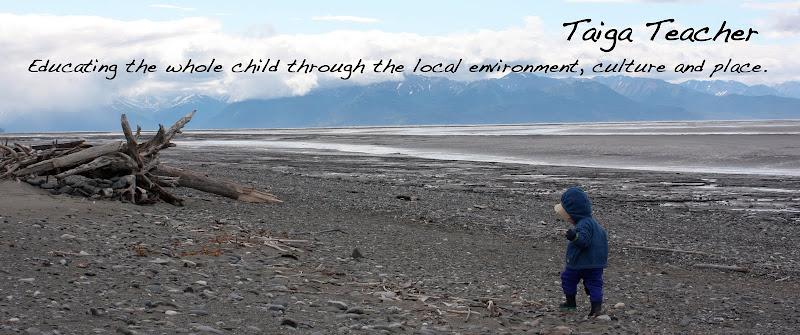 |
| The turn around point on my regular running trail in Kodiak. |
When I had my 3rd and 4th grade multi-age classroom in Fairbanks. I was in teacher paradise. I was in a Title 1 school, but was given a lot of freedom and autonomy to do what I felt best for my students. Part of that was an amazing administrator who knew I had a different situation teaching two grades, but also one who believed in multi-age and allowed me to make the decisions I needed to to make it truly work. I learned so much about my students having them for two years. I came to understand the breadth of the learning process. I also was challenged with creating new projects and approaches. You can not get in a rut when you teach multi-age like you can with a straight grade. Things have to be new and fresh each year because a large portion of your class you had the year before. One thing you can do is take a format that the kids know from one year and apply it to the next to allow them comfort and the ability to go deeper with their curiosity and study.

The first year I had my multi-age we did Moon Journals. The second year, the plant life cycle was part of our curriculum. We did Tree Journals. Students adopted a tree and observed it over the course of the school year. They drew about it, wrote about their observations, documented what they learned about trees and plants in general. One of my favorite things that came out of the year long study of trees was "Tree Movies." We had great big beautiful windows in our classroom that looked out to the trees lining the Noyes Slough that ran by the school. When students noticed the trees dancing in the wind, or the alpenglow on the frost of the trees at sunrise (late morning in the winter in Fairbanks) they would ask me to shut of the lights and we would quietly watch the "Tree Movie." A wonderful break in our busy routine and a communal experience of appreciation for the beauty of nature, remembering there was more to life than what remained inside the four walls of the classroom or the math problem in the workbook.
Study one tree, one place or one trail is important. We live in a culture where conquering is so important. Even people who spend much of their lives outdoors like to have conquests in the form of Peak Bagging or seeing as much of the world as they can. This is important, but just as important is getting to know one place well. My husband thinks it's funny that I like to run the same trail all the time. The only change is adding distance. I do this for many reasons... running the same course I know my body better and how much faster I can go, how much more I can push myself each time, but also I love noticing the weather patterns by seeing the sky from the same place over and over. I love seeing the same trail at different times of the day and noticing the subtle changes of the season from run to run. I enjoy walking the same trail and seeing things I totally missed when running by. I've known many places in my life by the trails I frequented. I mark milestones in my life by the way those trails looked as I traveled down them, processing the information from the day. One of the important things we owe our children is how to relate to spaces. Giving them the opportunity to get to know them intimately, deeply with out pushing them to keep moving on. At the same time we need to let them find that space. Plopping them down and telling them to love a place won't work. They need to choose the tree, trail, land, and..... decide when to move on... if they need to.
I think of a man I heard about once who climbs Mt. Monadnock in Southern New Hampshire every day for years. I wonder how much he understands about the world because he understands that one place. How much he has seen the landscape change and remain the same. Here's an article from
Yankee Magazine about him.
Much of the angst in my life has been leaving places I've come to know well and some of my greatest joys have been finding new ones.

